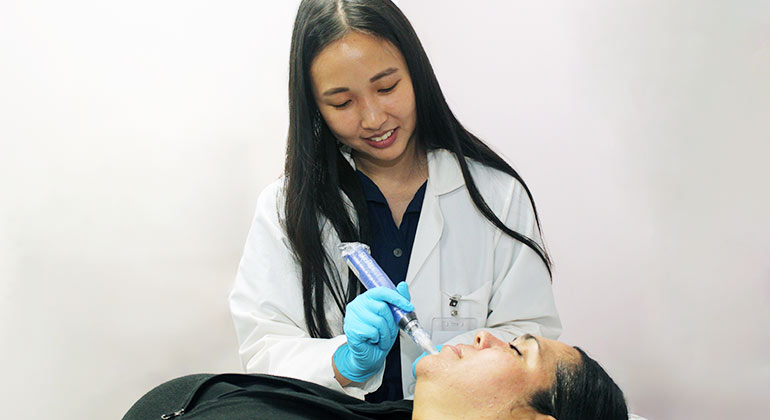Other Cosmetic Procedures

The Department of Dermatology at the Mount Sinai Health System offers a wide range of cosmetic surgical procedures. Some treatments are designed for challenges in specific locations, such as the eyelid, ear lobe, and buttocks. Others provide effective improvement in a variety of locations, including scar revision and mole removal. We use the very latest techniques and equipment, preferring minimally invasive approaches wherever possible, which decreases side effects and recovery time.
In addition, we appreciate the importance of appearance to your self-confidence and quality of life. Our care is always sensitive and geared to meet your individual challenges and needs. We are happy to be able to help you look and feel healthier.
Butt lift (liquid) with Sculptra®
Non-Surgical Butt Lift
Another minimally invasive and safe approach to the BBL involves using injectable biodegradeable fillers such as Scultptra® (Poly-L-Lactic acid). We inject this dermal filler into the buttock. This volumizes the area and stimulates your body to produce more collagen. You should see a fuller, rounder, more lifted buttock profile immediately. It also improves cellulite and skin texture.
Chemical Peels
We apply the solution to the skin surface, which removes the damaged outer layers. This stimulates collagen and improves skin tone and glow.
We offer a variety of chemical peels including:
- Jessner’s peel
- Glycolic acid peel
- Salicyclic acid peel
- Trichloracetic acid peel
- Phenol peel
Cosmetic Mole Removal
If you have a benign mole that you want removed for cosmetic reasons, we can help. First, we check to make sure that the mole is not cancerous. Then we use one of these approaches:
- CO2 Laser Ablation: The TrueSpot® Ultrapulse is a continuous wave CO2 laser. It removes the mole by destroying the pigment cells deep in the skin. We perform this five-minute procedure using topical numbing cream or local anesthetic injection. There is no surgery involved.
- Shave Removal: We use this technique to remove superficial moles. We use local anesthesia to help with pain. We can combine this quick and painless procedure with CO2 laser ablation.
- Excision: For deeper moles, we can perform an excision. First, we numb the area with a local anesthetic. We then use a scalpel to surgically remove the entire mole, after which we suture the area back together. We remove the sutures in a week or two, depending on the site. The procedure takes less than 30 minutes.
Earlobe Repair
Jewelry can stretch, tear, or damage earlobes. We can fix this with earlobe repair surgery. Under local anesthesia, we cut the damaged earlobe on each side, then suture it back together to reconstruct the earlobe. You can re-pierce the earlobe six months after the surgery. If you have a keloid scar on your earlobe from trauma or piercing, we can help. Treatments include topical treatments, injection treatments, laser treatments, and surgical treatments.
Micro-needling
Micro-needling allows us to treat fine lines and acne scars and improve skin texture, tone, and color. The Skinpen® works by piercing the skin with tiny needles to naturally stimulate collagen and elastin. It causes minimal epidermal damage and is safe in people with dark skin as well as fair skin. We can combine micro-needling with platelet rich plasma for even more dramatic results. Most people need several treatments for the best results.
Scar Revision
After surgery or injury, you may be left with an unsightly scar. Scars can be distressing due to their color, texture, elevation, depression, or width.
We address treatment to your individual scar and skin type. Our general approaches are:
- Redness: We can use a pulsed-dye laser to reduce redness, which takes two or three treatments. If your scar is brown, we can use a combination of topical creams and laser treatments.
- Texture: We can use injections, dermabrasion, resurfacing laser, microneedling, or platelet-rich plasma.
- Depressed Scar: We may use a minor surgical procedure called subcision along with injections of filler to make the scar much less visible. If your scar is wide, we may use surgical scar revision to make it thin, flat, and less visible.
In addition, we can also use one of these approaches:
- Dermabrasion involves the use of medical grade abrasion to mechanically resurface the skin and correct uneven skin texture and contour. The abrasion processes involves purposeful removal of the outer layers of skin to stimulate fresh collagen and even out texture. We use a local anesthetic for the procedure. We also use this treatment for improvement of nasal contour. We may combine dermabrasion with a resurfacing laser, depending on the scar.
- Scar resurfacing involves using special lasers. This approach creates microthermal treatment zones, which stimulates production of new collagen. The tissue then looks more like normal skin than scar tissue. We may combine this approach with dermabrasion for optimal results.